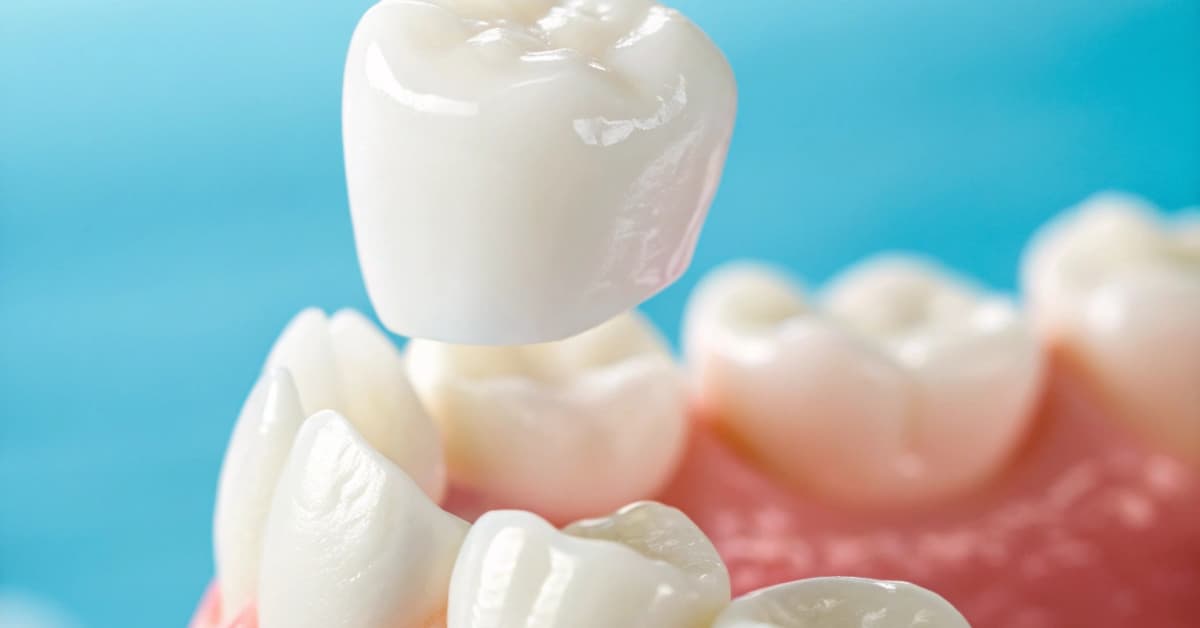Porcelain Crowns vs. Zirconia Crowns: Which Lasts Longer?
Your dentist just quoted prices for two different crown options – porcelain crowns and zirconia crowns – with a significant cost difference between them. You’re staring at treatment plans, wondering if the pricier option really lasts longer, or if you’re just paying for marketing hype.
I’ve watched this scenario unfold countless times in Las Vegas dental offices, where patients make thousand-dollar decisions based on incomplete information. Here’s what actually determines crown longevity – and why the “stronger” material doesn’t always mean longer-lasting.
Key Takeaways
- Zirconia durability: 1200 MPa strength vs. porcelain’s 100-300 MPa
- Real-world longevity: Both average 15-20 years with proper care
- Failure differences: Porcelain chips and fractures; zirconia causes opposing tooth wear
- Location matters: Back teeth benefit from zirconia; front teeth often better with porcelain
- Cost-per-year: Similar when longevity and replacement factors are calculated
Understanding Crown Materials: Beyond the Marketing
Let’s cut through the technical jargon. When dentists talk about porcelain crowns today, they usually mean lithium disilicate or layered ceramic. Zirconia refers to zirconium dioxide – a ceramic so tough it’s used in industrial applications. But here’s what surprised me after years of observation: laboratory strength doesn’t directly translate to mouth longevity.
Porcelain Crown Characteristics
Traditional porcelain crowns aren’t actually traditional anymore. Modern ceramics bear little resemblance to your grandmother’s dental work:
- Aesthetic advantage: Mimics natural tooth translucency
- Light transmission: Allows light through like real enamel
- Bonding capability: Chemically bonds to tooth structure
- Wear compatibility: Similar hardness to natural teeth
- Flexural strength: 100-400 MPa depending on specific ceramic
The “porcelain” label encompasses various ceramics – feldspathic, leucite-reinforced, and lithium disilicate. Each offers different properties, though patients rarely hear these distinctions.
Zirconia Crown Properties
Zirconia entered dentistry as the “unbreakable” crown material. The numbers support this reputation:
- Flexural strength: 900-1200 MPa (3-10x stronger than porcelain)
- Fracture resistance: Highest among dental ceramics
- Thickness requirements: Can be thinner, preserving tooth structure
- Color limitations: More opaque, less natural-looking
- Opposing wear: Can aggressively wear natural teeth
But strength creates its own problems. That industrial-grade hardness grinding against your natural teeth? Not always ideal.
Real Longevity Data: What Studies Actually Show
Here’s where patient assumptions often miss reality. Laboratory tests showing zirconia’s superior strength don’t tell the whole story. Clinical studies paint a more nuanced picture.
15-Year Survival Rates
Recent systematic reviews reveal surprising similarities:
- Porcelain crowns: 94.7% survival at 5 years, 85.3% at 15 years
- Zirconia crowns: 96.2% survival at 5 years, 87.1% at 15 years
- Statistical significance: Minimal difference in real-world longevity
- Failure patterns: Different modes but similar timelines
The 2% difference? Statistically insignificant when you factor in patient habits, hygiene, and placement location.
Why Lab Strength Doesn’t Equal Longevity
A crown fails for many reasons beyond material fracture:
- Margin decay: Affects both materials equally
- Cement failure: Depends on technique, not material
- Tooth fracture: The tooth underneath breaks, not the crown
- Periodontal issues: Gum disease doesn’t discriminate
- Aesthetic failure: Crown looks unacceptable before it breaks
I’ve seen “indestructible” zirconia crowns removed after 5 years due to gum recession, while 20-year-old porcelain crowns still function perfectly.
Failure Modes: How Each Material Breaks Down
Understanding how crowns fail helps predict which material suits your specific situation. Each material has characteristic failure patterns.
Porcelain Crown Failures
When porcelain crowns fail, they typically:
- Chip or fracture: Usually the facing layer, not catastrophic
- Wear through: Exposing underlying structure after 15-20 years
- Margin staining: Aesthetic failure at gum line
- Gradual degradation: Slow process you can monitor
Most porcelain failures are repairable or give warning signs. You’ll notice roughness, staining, or small chips before complete failure.
Zirconia Crown Failures
Zirconia fails differently:
- Opposing tooth wear: Damages natural teeth it contacts
- Catastrophic fracture: Rare but complete when it happens
- Cement bond failure: Doesn’t bond as well as porcelain
- Aesthetic degradation: Loses surface texture and shine
The “unbreakable” reputation means problems often involve surrounding structures rather than the crown itself.
Optimal Dental Crown Location: Where Each Material Excels
Your tooth’s position in your mouth matters more than most patients realize. Front teeth face different challenges than molars.
Front Teeth Considerations
For incisors and canines, aesthetics usually trump strength:
- Lower bite forces: 150-200 PSI vs. 500+ PSI on molars
- Aesthetic demands: Must match adjacent teeth perfectly
- Light transmission: Critical for natural appearance
- Porcelain advantage: Superior aesthetics worth strength trade-off
I rarely recommend monolithic zirconia for front teeth unless patients have severe grinding habits or aesthetic expectations are low.
Back Teeth Requirements
Molars face punishment front teeth never experience:
- Maximum bite forces: Up to 900 PSI during clenching
- Reduced aesthetic concern: Less visible during smiling
- Grinding surfaces: Constant wear from chewing
- Zirconia advantage: Strength matters more than beauty
Yet even here, super-strong zirconia can cause problems if you have natural teeth opposing it.
The Henderson/Las Vegas Factor: Local Considerations
Living in the desert affects dental materials differently than coastal climates. Our unique environment creates specific challenges:
Dry Climate Effects
- Increased mouth breathing: Dries oral tissues and cement
- Dehydration risk: Reduces saliva’s protective effects
- Material stability: Both materials handle dry conditions well
- Cement longevity: May decrease in chronic dry mouth
Lifestyle Factors
Las Vegas lifestyles create unique stresses:
- 24/7 schedules: Irregular sleep increases grinding
- Entertainment industry: Higher aesthetic demands
- Transient population: Continuity of care challenges
- Hard water: Affects oral pH and material wear
Cost Analysis: Beyond the Initial Price Tag
Let’s talk real numbers for Las Vegas valley patients. The initial cost difference seems significant until you calculate cost-per-year of service.
Typical Local Pricing
- Porcelain crowns: $1,200 – $2,000 per tooth
- Zirconia crowns: $1,400 – $2,500 per tooth
- Lab fee differences: Zirconia adds $100-300 to costs
- Insurance coverage: Usually identical regardless of material
True Cost Calculation
Assuming 15-year average lifespan for both:
- Porcelain: $1,600 ÷ 15 years = $107/year
- Zirconia: $1,950 ÷ 15 years = $130/year
- Difference: $23/year or $1.92/month
- Replacement factor: Similar for both materials
The premium for zirconia becomes negligible when amortized over the crown’s lifetime.
Technological Advances: What’s Changed Recently
Crown technology evolves rapidly. What was true five years ago may not apply to today’s materials.
Modern Porcelain Improvements
- Lithium disilicate: 400 MPa strength vs. old porcelain’s 100 MPa
- CAD/CAM precision: Better fit means longer life
- Bonding advances: Chemical bonds rival mechanical retention
- Aesthetic options: Multiple translucency levels available
Zirconia Evolution
- Cubic zirconia: More translucent than original versions
- Layered options: Porcelain over zirconia combines benefits
- Surface treatments: Reduced opposing tooth wear
- 5Y-PSZ formulations: Balance strength with aesthetics
Today’s materials blur traditional distinctions between porcelain and zirconia.
Making Your Crown Material Decision
After analyzing hundreds of crown outcomes, here’s my decision framework:
Choose Porcelain When:
- Front tooth replacement: Aesthetics are paramount
- Matching adjacent teeth: Natural teeth or existing porcelain
- Normal bite forces: No grinding or clenching habits
- Good tooth structure: Adequate support remains
- Budget conscious: Slightly lower initial cost
Choose Zirconia When:
- Molar replacement: Maximum strength needed
- Grinding habits: Bruxism or clenching present
- Limited space: Thin crown requirements
- Bridge support: Multiple unit restorations
- Previous crown fractures: History of broken restorations
Questions for Your Consultation
Don’t let technical details overwhelm your decision. Ask these specific questions:
- “Based on my bite pattern, which material suits this specific tooth?”
- “What type of porcelain or zirconia generation are you recommending?”
- “How many of each type have you placed, and what failures have you seen?”
- “Will this material work well with my existing dental work?”
- “What’s your warranty or remake policy for each material?”
The Verdict: Longevity Depends on More Than Material
Here’s the truth that crown manufacturers don’t advertise: patient factors affect longevity more than material choice. Your oral hygiene, diet, habits, and genetics play larger roles than porcelain versus zirconia.
Both materials, when properly placed and maintained, last 15-20 years on average. Zirconia’s strength advantage matters most for grinders and molar replacements. Porcelain’s aesthetic advantage makes it ideal for visible teeth and patients with normal bite forces.
The “which lasts longer” question misses the point. Ask instead: “Which material best suits my specific tooth, location, habits, and goals?” That personalized answer – not generic strength numbers – leads to crown success.
Your crown investment protects your tooth for decades. Whether porcelain’s beauty or zirconia’s brawn serves you better, choose based on your unique situation, not marketing claims. Both materials, in the right circumstances, deliver the longevity you’re paying for.
Ready to crown that tooth? Discuss both options with your dentist, considering your specific needs beyond simple strength comparisons. Your smile deserves a material matched to its unique demands.



